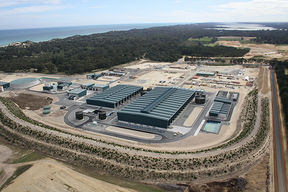| Desal Plant Profile - Southern Seawater Desalination Plant
|
 Labelled aerial photo of Southern Seawater Desalination Plant Labelled aerial photo of Southern Seawater Desalination Plant
|
|
|
| Total capacity:
|
273 ML/day
|
| Date commissioned:
|
2011 (Stage 1); 2013 (Stage 2)
|
| Feed water TDS:
|
35000 mg/L - 38000 mg/L
|
| Product water TDS:
|
200mg/L
|
| Percent of water supply:
|
31% of Perth
|
| feed water temperature (low):
|
15°C
|
| Feed water temperature (high):
|
24°C
|
| Seawater intake system:
|
Open Intake
|
| Pretreatment system:
|
Travelling Band Screens, UF PVDF Pressure Filters, 5 Micron Cartridge Filtration
|
| RO operating pressure:
|
First pass RO operating pressure - 64 bar (45% recovery). Second pass - 15 bar (85% recovery)
|
| RO passes:
|
2
|
| RO trains:
|
8 first pass trains, 4 second pass trains
|
| Post-treatment system:
|
Lime stabilization, CO2
|
| Concentrate disposal:
|
Brine diluted and discharged into the ocean
|
| Energy consumption:
|
3.6 kWh/m3
|
| Energy recovery:
|
Pressure exchanger
|
| Capital cost:
|
$1150 million (Stage 1: $700 million. Stage 2: $450million)
|
 Labelled aerial photo of Southern Seawater Desalination Plant
Labelled aerial photo of Southern Seawater Desalination Plant